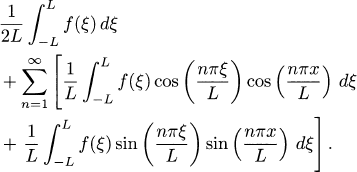Chapter 5
Fourier Integral Methods of Solution
To solve problems on bounded intervals, we often use Fourier series. For problems on a line or half line, where the space variable is unbounded, we may turn to Fourier integrals.
Such problems can have both theoretical and modeling implications. To a radio astronomer, radio waves in space may be modeled as traveling along an infinite line. And to a sonar operator in a submarine, the ocean may look like an infinite medium.
We will begin with an informal development of the Fourier integral and sine and cosine integrals, then look at their uses in solving initial-boundary value problems.
5.1 The Fourier Integral of a Function
Suppose f(x) is piecewise smooth on every interval [−L, L], and that f is absolutely integrable, which means that ∫∞−∞ |f(x)| dx converges.
Instead of writing a Fourier series representation of f(x) on an interval [−L, L], we want to attempt a representation that is in some sense valid for all x.
Choose any L > 0 and start with the Fourier expansion of f(x) on [−L, L],
ignoring f(x) for |x| > L. This expansion is

We would like to let L → ∞ in this expression to attempt a representation of f(x) over the entire real line. To determine this limit (at least intuitively), let ωn = nπ/L to write
![]()
Upon substitution, the Fourier ...
Get Beginning Partial Differential Equations, 3rd Edition now with the O’Reilly learning platform.
O’Reilly members experience books, live events, courses curated by job role, and more from O’Reilly and nearly 200 top publishers.

